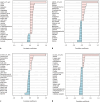PROVIT-CLOCK: A Potential Influence of Probiotics and Vitamin B7 Add-On Treatment and Metabolites on Clock Gene Expression in Major Depression
- PMID: 38776887
- PMCID: PMC11548105
- DOI: 10.1159/000538781
PROVIT-CLOCK: A Potential Influence of Probiotics and Vitamin B7 Add-On Treatment and Metabolites on Clock Gene Expression in Major Depression
Abstract
Introduction: An increasing body of evidence suggests a strong relationship between gut health and mental state. Lately, a connection between butyrate-producing bacteria and sleep quality has been discussed. The PROVIT study, as a randomized, double-blind, 4-week, multispecies probiotic intervention study, aims at elucidating the potential interconnection between the gut's metabolome and the molecular clock in individuals with major depressive disorder (MDD).
Methods: The aim of the PROVIT-CLOCK study was to analyze changes in core clock gene expression during treatment with probiotic intervention versus placebo in fasting blood and the connection with the serum- and stool-metabolome in patients with MDD (n = 53). In addition to clinical assessments in the PROVIT study, metabolomics analyses with 1H nuclear magnetic resonance spectroscopy (stool and serum) and gene expression (RT-qPCR) analysis of the core clock genes ARNTL, PER3, CLOCK, TIMELESS, NR1D1 in peripheral blood mononuclear cells of fasting blood were performed.
Results: The gene expression levels of the clock gene CLOCK were significantly altered only in individuals receiving probiotic add-on treatment. TIMELESS and ARNTL gene expression changed significantly over the 4-week intervention period in both groups. Various positive and negative correlations between metabolites in serum/stool and core clock gene expression levels were observed.
Conclusion: Changing the gut microbiome by probiotic treatment potentially influences CLOCK gene expression. The preliminary results of the PROVIT-CLOCK study indicate a possible interconnection between the gut microbiome and circadian rhythm potentially orchestrated by metabolites.
Keywords: Circadian clock genes; Gut-brain axis; Major depressive disorder; Randomized controlled trial.
© 2024 The Author(s). Published by S. Karger AG, Basel.
Conflict of interest statement
The authors declare no conflict of interest.
Figures







References
-
- Chmielewska N, Szyndler J, Maciejak P, Plaznik A. Epigenetic mechanisms of stress and depression. Psychiatr Pol. 2019;53(6):1413–28. - PubMed
Publication types
MeSH terms
Substances
Grants and funding
LinkOut - more resources
Full Text Sources

